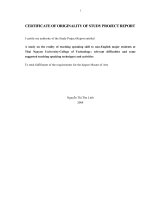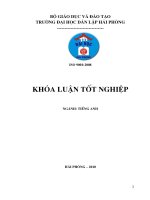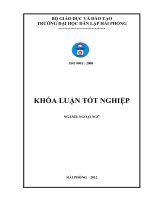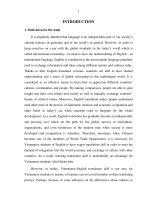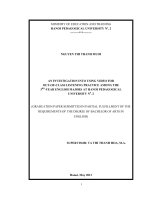the impacts of task based instruction on grammatical performance of pre intermediate non english majors at van lang university
Bạn đang xem bản rút gọn của tài liệu. Xem và tải ngay bản đầy đủ của tài liệu tại đây (1.18 MB, 158 trang )
MINISTRY OF EDUCATION AND TRAINING
HO CHI MINH CITY OPEN UNIVERSITY
ĐỖ THỊ HUYỀN
THE IMPACTS OF TASK-BASED INSTRUCTION ON GRAMMATICAL
PERFORMANCE OF PRE-INTERMEDIATE NON-ENGLISH MAJORS
AT VAN LANG UNIVERSITY
MASTER OF ARTS IN TESOL
Ho Chi Minh City, 2019
MINISTRY OF EDUCATION AND TRAINING
HO CHI MINH CITY OPEN UNIVERSITY
ĐỖ THỊ HUYỀN
THE IMPACTS OF TASK-BASED INSTRUCTION ON GRAMMATICAL
PERFORMANCE OF PRE-INTERMEDIATE NON-ENGLISH MAJORS
AT VAN LANG UNIVERSITY
Major: Teaching English to Speakers of Other Languages
Major code: 60140111
MASTER OF ARTS IN TESOL
Supervisor: Assoc. Prof. PHAM VU PHI HO, PhD.
Ho Chi Minh City, 2019
i
STATEMENT OF AUTHORSHIP
I certify that this thesis entitled “The impacts of Task-based Instruction on
grammatical performance of pre-intermediate non-English majors at Van Lang
University” is my own work.
Except where reference is made in the text of the thesis, this thesis contains
any material published elsewhere or extracted in whole or in part from a thesis by
which I have qualified for or been awarded another degree or diploma.
No other person’s work has been used without due acknowledgement in the
main text of the thesis.
This thesis has not been submitted for the award of any degree or diploma in
any other tertiary institution.
Ho Chi Minh City, September 2019
DO THI HUYEN
ii
ACKNOWLEDGEMENTS
Firstly, I would like to express my gratitude to my supervisor,
Ass. Prof., Dr. Pham Vu Phi Ho, who spent his valuable time on giving me
instructions, advice, constructive comments, and encouragement. This thesis would
not have been completed if it had not been for his great support.
Secondly, I would like to thank my colleagues and classmates who encouraged
me and shared with me much experience in thesis writing.
Thirdly, I am also grateful for all lecturers and staff at the Open University,
Ho Chi Minh City, who instructed me and equipped me with relevant information
and shared knowledge.
Finally, thanks to all my beloved first-year students at Van Lang University,
the data collection and teaching procedures could be finished on time.
iii
ABSTRACT
The quasi-experimental research was conducted to investigate the impacts of
Task based Instruction on Pre-intermediate non-English majors at Van Lang
Univerisity. Mixed method was employed using Pre-test, post-test and interview to
respond to the three research questions. The research lasted eight weeks on two
groups of students (1) the control group studying grammar through PPP (2) the
experimental group studying grammar through TBI with five grammatical points.
The findings indicate that TBI approach has a significant impact on the preintermediate non-English majors’ grammatical performance. The students’ attitudes
towards TBI group is more positive than that towards PPP group. However, in terms
of grammatical performance in writing and speaking, TBI model is not superior to
PPP model.
Key words: Task based Instruction, grammatical performance, PPP,
attitudes, speaking, and writing.
iv
TABLE OF CONTENTS
STATEMENT OF AUTHORSHIP…...………………………………………….....i
ACKNOWLEDGEMENTS…..……………………………………………………..ii
ABSTRACT………………………………………………………………………..iii
TABLE OF CONTENTS…………………………………………………………...iv
LIST OF TABLES………………………………………………………………….ix
LIST OF FIGURES……………………………………………………………….viii
ABBREVIATIONS………………………………………………………………...xi
CHAPTER 1 – INTRODUCTION .............................................................................1
1.1. Background of the study ...................................................................................1
1.2. Statement of the problems ................................................................................5
1.3. Aims of the study ..............................................................................................8
1.4 Research questions .............................................................................................8
1.5. Significance of the study ..................................................................................9
1.6 Structure of the study .........................................................................................9
CHAPTER 2 - LITERATURE REVIEW .................................................................12
2.1. Theoretical framework....................................................................................12
2.1.1. Definition of grammar .............................................................................. 13
2.1.2. Grammatical performance ........................................................................ 13
2.1.3. How to teach grammar ............................................................................. 14
2.2. Previous studies ..............................................................................................28
2.3 Research gaps ..................................................................................................34
2.4 Chapter summary .............................................................................................36
CHAPTER 3 – RESEARCH METHODOLOGY ....................................................37
v
3.1 Research design ...............................................................................................37
3.2. Research setting and participants....................................................................38
3.2.2. Participants...................................................................................................39
3.3. Instruments......................................................................................................41
3.3.1. Pre-test and Post-test ................................................................................ 42
3.3.2. Interview ................................................................................................... 45
3.4. Research procedure .........................................................................................47
3.5 Training procedure ...........................................................................................50
3.5.1 Traditional PPP lessons ............................................................................. 50
3.5.2. TBI lessons ............................................................................................... 51
3.6 Data Collection and Analysis ..........................................................................55
3.7 Chapter summary .............................................................................................56
CHAPTER 4– RESULTS, FINDINGS AND DISCUSSION ..................................57
4.1 Reliability of the marking of speaking and writing .........................................57
4.2. Grammatical performance of the two groups before the treatment ................58
4.2.1. Pre-grammar paper test ............................................................................ 58
4.2.2. Pre-writing test ......................................................................................... 59
4.2.3. Pre-speaking test ...................................................................................... 59
4.3. Research question 1 ........................................................................................60
4.3.1. Comparison of the pre-grammar test & post-grammar test ..................... 61
4.3.2 Comparison of the post-grammar test ....................................................... 62
4.4. Research question 2 ........................................................................................63
4.4.1. Comparison of the pre-speaking test & post-speaking test ...................... 63
vi
4.4.2. Comparison of the post-speaking tests of the TBI group and PPP group 64
4.4.3. Comparison of the pre-writing test & post-writing test ........................... 65
4.4.4. Comparison of the post-writing test ......................................................... 66
4.5. Research question 3 ........................................................................................67
4.5.1 Interviews after each lesson ...................................................................... 67
4.5.2. Interviews after the whole treatment ........................................................ 75
4.6. Discussion .......................................................................................................79
4.6.1. The impacts of on the pre-intermediate non-English-majors' grammatical
performance in the grammar-paper test at Van Lang University....................... 79
4.6.2. The impacts of on the pre-intermediate non-English-majors' grammatical
performance in speaking and writing test Vat an Lang University .................... 81
4.6.3. The attitudes of learners towards the teaching grammar through TBI and
PPP ..................................................................................................................... 81
CHAPTER 5 – CONCLUSION, IMPLICATIONS AND RECOMMENDATIONS
...................................................................................................................................85
5.1. Summary of the research findings ..................................................................85
5.2 Conclusion .......................................................................................................86
5.3 Pedagogical implications .................................................................................87
5.4. Limitations and recommendations ..................................................................88
References .................................................................................................................90
APPENDIX A – LESSON PLAN.............................................................................97
LESSON 1 – PRESENT CONTINUOUS FOR FUTURE USE ...........................97
LESSON 2 – MUST/MUSN’T/HAVE/DON’T HAVE TO/CAN/CAN’T ........101
LESSON 3 – MIGHT/MAY/WILL PROBABLY ..............................................104
vii
LESSON 4 – ZERO CONDITIONAL ................................................................110
LESSON 5 – FIRST CONDITIONAL ................................................................112
APPENDIX B- TRANSCRIPT OF INTERVIEW AFTER EACH LESSON .......114
APPENDIX C –TRANSCRIPT OF INTERVIEW AFTER THE WHOLE
TREATMENT.........................................................................................................128
APPENDIX E – POST-TEST .................................................................................142
viii
LIST OF FIGURES
Page
Figure 3.1 English training program at Van Lang University according to CEFR
……………………………………………………………………………………...38
Figure 3.2 Demographics of participants ………………………………………....39
Figure 3.3 Correspondence between the research questions and the
research instruments ………………………………………………………………46
Figure 3.4 Training procedure for PPP lessons …………………………………...52
Figure 3.5 Training procedure for TBI lessons ……………………………………53
ix
LIST OF TABLES
Page
Table 3.1 The participants of the study……………………………………………40
Table 3.2 Specifications of the pre-test and post-test (Adapted from A2 Key exam
forma KET – Cambridge English) …………………………………………….......43
Table 3.3 Assessment scales for grammatical performance in writing and speaking
……………………………………………………………………………………...44
Table 3.4 Time allocation for the study …………………………………………..48
Table 3.5 Production activities ……………………………………………………49
Table 3.6 Types of task used in the treatment …………………………………….50
Table 4.1 Reliability Statistics of the test scores marked by the interraters ………57
Table 4.2 Summary of pre-grammar test result …………………………………...57
Table 4.3 Independent samples t-test of pre-wiring test…………………………...58
Table 4.4 Independent samples t-test of pre-speaking test………………………...59
Table 4.5 Paired samples t-test of grammar-paper test (PPP)……………………...60
Table 4.6 Paired samples t-test of pre-test & post-test of grammar paper test
(TBI)………………………………………………………………………………..61
Table 4.7. Independent samples t test of post-grammar test ………………………62
Table 4.8. Paired samples t-test of pre-speaking and post-speaking tests
of TBI & PPP group ……………………………………………………………….63
x
Table 4.9. Paired Samples t-tests of post-speaking tests between TBI group and PPP
group ………………………………………………………………………………64
Table 4.10 Paired Samples t-tests of pre-writing test and post- writing test
………………………………………………………………...................................64
Table 4.11 Paired samples t-test of post-writing test ……………………………...66
Table 4.12 Students’ understanding of the lesson …………………………………69
Table 4.13 Students’ preferences ………………………………………………….72
Table 4.14. Difficulties ……………………………………………………………74
Table 4.15. Expectations …………………………………………………………..74
Table 4.16 Findings of the interviews after the whole treatment …………………78
xi
ABBREVIATIONS
CEFR
: Common European Framework of References for Languages
EFL
: English as a Foreign Language
ELT
: English Language Teaching
ESL
: English as a Second Language
PPP
: Presentation, Practice, Production
TBI
: Task Based Instruction
L1
: First language or mother tongue
L2
: Second language
SLA
: Second Language Acquisition
1
CHAPTER 1 – INTRODUCTION
Chapter 1 includes six sections to provide an overview of the research.
Firstly, it provides a background of the study which states the current teaching of
grammar and language teaching and learning in Section 1.1. It is followed by
Section 1.2 to address the problems in the TEFL in general and in the researcher’
teaching practice. The next section reveals the research rationale. In the fourth
section, research questions are presented as the guidance to carry out the research.
Section 1.5 discusses the significance of the study. The last section summarizes the
structure of the study.
1.1 Background of the study
As can be seen from the history of teaching and learning English as a foreign
language, grammar has received much attention among the ELT experts. Crystal
(2004) highlighted the importance of grammar that it was the skeleton or even the
nervous system of a language. It helps to express ourselves as a structural basis,
increase precision and decrease ambiguity. Over the centuries of ELT research,
experts have acknowledged the importance of teaching grammar in any courses.
Without grammar, words can become chaotic and meaningless. Therefore, teaching
and learning grammar is also vital in the language learning process.
However, grammar has become the central controversy on the teaching
methods along with the trends towards language teaching approaches. It was once
the utmost factor in Grammar Translation Method while experts in Direct Method
believed that grammar had no significant role to play in the FL learning process
(Klapper, 2006).
Despite of that, in recent research, many researchers agreed that learners who
have exposure to linguistic form during communicative interaction are more
2
successful than those who have never been awarded of form or who are only
exposed to decontextualized grammar lessons (Larsen-Freeman, 2003). Ellis (2006)
argued that “Grammar Teaching involves any instructional technique that draws
learners’ attention to some specific grammatical form in such a way that it helps
them either to understand it metalinguistically and / or process it in comprehension
and / or production so that they can internalize it.” (p. 84). Also, Azar (2007)
mentioned that those who were exposed to grammar instruction had better language
comprehension than those who had not. The mentioned findings can highlight the
significance of grammar teaching in the second language acquisition.
Despite the importance of grammar in the process of language learning,
grammar has appeared to be the most difficult aspect for learners to learn (Sawir,
2005). Accordingly, it has become one of the problems that EFL learners normally
face. Shatz and Wilkinson (2010) highlighted that second language (L2) learners
usually cannot express their complex thoughts because they are unable to produce
complex sentences. Azimi (2016) found out that many learners had difficulties in
applying grammar in real-life situations. They couldn’t express themselves clearly.
To investigate the causes of grammar difficulties, in a study conducted in
Saudi Arabia, Alhaysony & Alhaisoni (2017) pointed out that learners’ motivation
is one of the main factors that is involved. The researchers stated that many learners
lack of motivation to use the grammar appropriately and even to learn grammar.
In addition to learners’ motivation, teaching methodology is the leading
feature that affects the learning outcome. Widdowson (1979) argued that learners
‘success to use the language could be traced back to teaching and learning
approach. As can be seen in the history of EFL learning and teaching, different
approaches have been introduced and practiced. EFL practitioners and learners have
experienced Grammar Translation Method (GTM), Direct Method (DM), Audio
3
Lingual Method (ALM) and Communicative Language Teaching (CLT). Due to
their drawbacks, nowadays, GTM, DM and ALM are rarely used in the classrooms.
In DM (or sometimes called Natural Method), the theory underlying is that
FL should be acquired through experience (Klapper, 2006). Therefore, there was no
room for L1 or explicit grammar instruction. However, the majority of scholars
criticised DM because of it shortcomings including inadequate lengths to avoid L
while the learning process would be a lot better facilitated by brief and immediate
use of learners’ first language. Furthermore, the fact is that there is still a number of
tutors who are not fully proficiency in FL. This appears to affect the learners’
learning outcome when they are dependent on the ability of the tutor and his or her
FL proficiency.
As for ALM, this method based significantly on “drilling, the formation of
habit and the avoidance of error” (Klapper, p.107). In the 1960s, ALM was
criticised by many linguists in which it theoretical foundation was weak and the
learners were unable to use the language learnt in their real communication
(Richards & Rodgers, 1987). Klapper (2006) also argued that ALM emphasized the
formal structured rather than their meaning. Therefore, the learning was dull and
demotivating. Learners also have little chance to practice FL in meaningful
communication.
GTM used to be the popular method implemented in the course books and
classrooms. It was a traditional and long-standing method which was emerged in the
eighteen century. It promotes the notion of learning a language through grammar
(Banerjee, 2016). As presented by Harmer (2007), GTM provides learners with
explanations of grammatical points and exemplifying sentences. Typically,
according to Klapper (2006), the rules of grammars are deductively presented and
practiced through translation of sentences. The role of L1 is vital since the sentences
4
were translated from the target language to the students’ first language and vice
versa. Although GTM was once the standard method in most schools, it revealed a
lot of defects that prevents learners from using the language in meaningful contexts.
Firstly, GTM features the complex level of grammar with a wide range of
grammar points. According to Klapper (2006), the language knowledge taught is
complicated and does not serve fluent, natural use of the FL. In fact, in many GTM
classrooms, the students are provided with a highly complicated structures and
forms accompanied with a plenty of mechanical exercises that they cannot use in
real communication.
Secondly, written translation is mainly conducted to serve the sole deductive
process of language learning; meanwhile, meaningful aural input and the teaching
of FL reading skills have a little position in the teaching. In reality, the learners are
exposed to and acquire the language through listening and reading. They also need
to produce the language without spending time to translate exactly one language to
another. In other words, it does not reflect the actual learning process and reserves
that procedure (Khan & Mansoor, 2016).
Last but not least, oral and written strategies for meaningful communication
are taken into little consideration. As mentioned earlier, the main activities in a
GTM lesson is reading, doing mechanical exercise and translation. Therefore, there
seems to be no room for meaningful communication.
In the recent years, due to a lot of problems, the GTM method was replaced
by CLT approach. it seems that the most widely known and used methodology in
the current course books and classrooms is CLT. In this approach, the PPP
(Presentation-Practice-Production) model is the paradigm to teach grammar.
Although PPP has been widely used since 1960s (Harmer, 2007) as a useful
teaching procedure which is easy to follow and organize, it has been proved
5
problematic. Willis (1996) demonstrated that learners who are taught with the PPP
model are not successful in communicating outside the classroom, particularly with
native speakers. It means that the aim of the production stage is not fully achieved.
Other scholars rejected this framework according to psychological viewpoint
(Skehan, 1996; Harmer, 2001; Ellis, 2003). They asserted that learners do not
acquire the language in the order in which they need previous practice before
production. In fact, learners take the learning process with transitional stages,
known as interlanguage. The PPP model, accordingly, is too behavourist and linear
(Ellis, 2003).
1.2 Statement of the problems
As mentioned earlier, teaching grammar seems to receive much attention due
to many issues and difficulties faced by both teachers and learners. The major
problem includes the fact that a number of learners cannot apply the grammatical
structures in communication such as writing and speaking. As claimed by Rodgers
and Richards (2014), although PPP lessons incorporate skills into lessons, most
students were not able to communicate effectively in English. Moreover, many
learners demonstrated that they are unwilling to learn grammar and that grammar is
a demotivating factor of learning.
As for the first issue, a lot of studies pointed out that communication of a
great number of learners is still not effective since they don’t know what grammar
to use and how to use it appropriately. Effendi et al (2017) carried out a study in
Indonesia to find out the approaches applied by the teachers, difficulties of the
students in their grammar learning and their grammar ability. The findings showed
that there is a variety of methods applied. Although CLT is used with the focus of
communication, the students revealed their difficulties in learning grammar. They
also showed their lack of motivation to study grammar.
6
The second major problem that critically affects the grammar learning
outcome is the students’ lack of motivation for learning grammar. As stated by
Burner (2005), many students in his study showed their low level of grammatical
knowledge when they write a lot of incorrect English. In addition, the learners
regarded learning grammar as boring, out-of-date with too many rules. They even
wish to exclude grammar out of the curriculum.
In Vietnamese context, the researcher also noted that a number of learners
find difficulties in their real-life communication. According to a statistics by
Ministry of Education and Training, in 2018, 78 percent of high school students got
below the average score on the English test, and the average score was 3.91 on the
10-score scale (Chi, 2018). Another report by Chi (2018) showed that almost
employers complained that the university graduates cannot communicate
effectively. Another problem is that, although more and more teachers applied CLT
with communicative activities, many learners seem to show their demotivation in
the grammar lessons.
In the researcher’s teaching practice at Van Lang University, there is a
number of students who have difficulties in their grammatical knowledge and use
although they have studied English for seven years or more. Their performance in
the placement test generally indicates their average level is at elementary. The
current course book (American Jetstream) used is an integrated one with the
grammar focus incorporated in listening or reading sections in which the underlying
procedure is PPP. However, teaching the grammar through listening and reading
emerges some drawbacks. Firstly, the presentation of the grammar rules does not
quite engages the students in the lesson. Also, the students often reveal that they are
not quite eager to take the grammar lessons with many practice exercises. The tests
might be the trigger for them to study the grammar points.
7
To resolve the problems, Pham (2015) suggested that the PresentationPractice-Production should be maintained but need further improvement by
teaching them in contexts through communicative tasks. In PPP teaching model,
leaners study grammar through 3 stages namely Presentation, Practice and
Production. Accuracy and fluency are expected to achieved through Practice and
Production. However, interactive and communicative tasks should be embedded so
that leaners can explore grammar while using their existing grammatical
knowledge. This technique will not only help leaners learn more actively but also
develop their autonomy in languge learning (Pham, 2015).
Following the notion that language learning needs to be involved in real
communication in which learners use the language in a meaningful way, Task-based
Instruction (TBI) has been the increasing interest among ELT experts as well as
teachers (Nunan, 2004). It can be seen as a development of CLT, in which fluency
activities through tasks should be lead gradually to accuracy-focused activities
(Klapper, 2006). According to Richards and Rogers (2001), “Tasks are believed to
foster a process of negotiation, modification, rephrasing and experimentation that
are at the heart of second language learning” (p. 228). Furthermore, Bahrami (2010)
claimed that Task-based Instruction helped boost learners’ intrinsic motivation.
Last but not least, despite the fact that TBI has received much attention these
days, from the researcher’s experience, in Vietnamese context, it appears that many
teachers are vague about this new teaching approach. Especially, many of them are
familiar with traditional methods such as GTM or CLT with PPP model and
unwilling to take the new approach. Furthermore, up till now, there is little research
in the field of TBI conducted in Vietnamese context. Especially there is a gap in
grammar teaching through TBI and its impact on the students’ grammatical use in
communication.
8
1.3 Aims of the study
In view of the above current shortcomings of grammar teaching and an
interest in a new teaching approach, the researcher was motivated to carry out a
study on the impacts of Task-based Instruction on grammar performance of preintermediate non-English majors at Van Lang University. First and foremost, the
study is aimed to investigate if TBI has a significant effect on the learners’
grammatical performance in their speaking and writing s./kills. As a result, it could
help the stakeholders in finding ways to improve the current teaching and learning
of grammar in order to help the leaners communicate effectively with appropriate
grammar use.
Secondly, the research attempted to find out the learners’ attitudes towards
the implementation of the new approach since motivation has a significant influence
on the learning process and learning outcome as one of the affective factor. Through
the results, the research can propose further significant implications for the English
language teaching at Van Lang University as well as other educational institutions.
1.4 Research questions
The above mentioned problems motivated the researcher to perform an
experiment on TBI in grammar teaching in her own pre-intermediate non-English
majors at Van Lang University and investigate its impacts on their grammar
performance. The study was performed to answer the following research questions:
1. To what extent does TBI impact on the pre-intermediate non-English-majors'
grammatical performance in the grammar paper test at Van Lang University?
2. To what extent does TBI impact on the pre-intermediate non-English-majors'
grammatical performance in the speaking and writing test at Van Lang University?
9
3. What are the attitudes of the pre-intermediate non-English-majors towards
teaching grammar through TBI and PPP?
1.5. Significance of the study
The current language teaching and learning appears to remain the problems
in the learners’ effective communication skills in which grammar is still
controversial debate among the practitioners and an obstacle for many learners. The
research and its findings will suggest how to tackle this remaining issue.
As can be seen in the research field, although there is a number of studies on
the implementation of TBI, there is little research on its impact on the learners’
grammar performance, the study will shed the light on this gap, particularly in the
setting of higher education. It also may suggest ways to improve the teaching and
learning of speaking and writing skills or other related research fields.
The research will contribute to raise the teachers’ awareness of considering
unceasing learning of new methods as well as adapting the materials. The findings
and the how the TBI approach was implemented are expected to inspire the teachers
to apply this new method in teaching grammar as well as other language skills and
areas.
Last but not least, the researcher hopes to provoke the curriculum designers
to take this method into consideration in their planning process so that more
meaningful tasks can be integrated into the syllabus.
1.6 Structure of the study
The study is constituted by five chapters:
Chapter 1 – Introduction
10
The aim of this chapter is to provide an overview of the teaching and
learning grammar and the problems in the associated field as well as in the
researcher’ teaching practice. Accordingly, it clearly states the rationale of the study
to solve the mentioned problems with the research questions as the guidance to
implement the necessary instruments. It also highlights the significance of the
research in the field of language teaching and learning.
11
Chapter 2 – Literature review
The related theoretical framework for grammar, grammar teaching and
learning was provided to give an overall and sufficient view related theories as a
foundation for the researcher to implement the new approach.
Previous studies related to the topic were critically reviewed and discussed in
an attempt to find out what else the research can do to contribute to the field.
Chapter 3 – Research methodology
This chapter gives details of the research design the researcher employed, the
research setting, research participants and the data collection procedure including
the instruments, research procedure and detailed training procedure.
Chapter 4 – Data analysis
The analysis of the study was arranged according to the research questions
with detailed discussion for the findings.
Chapter 5 – Conclusion
This chapter summarizes the process of the research with major findings and
provides implications to the various stakeholders. Limitations of research are also
discussed for further improvement and research.
12
CHAPTER 2 - LITERATURE REVIEW
This chapter presents the theoretical framework with the definition of
grammar and the importance of teaching grammar. It also defines the notion of
grammatical performance as the key words in this research to clarify the scope of
work. The chapter also examines the popular PPP model which is employed as the
control method together with the highlight of experimental TBI model and its
principles. Advantages and disadvantages of each method are also taken into
consideration.
Following the theoretical framework, the research discusses previous studies
conducted on the field of Task Based Instruction and its impact on grammar
teaching and learning. The purpose of this chapter is to gain an understanding of its
historical context and foundation to conduct the study. Particularly, the research
gaps are identified to be further fulfilled.
2.1 Theoretical framework
Of all language components, grammar can be considered as the foundation in
communication and language learning. Meanings can be conveyed more easily, if
grammatically correct sentences are used. In the past, teaching grammar was the
most essential part of language instruction to the extent that other aspects were
somehow ignored. It was believed that by knowing grammatical rules, learners
could use the language for communication. However, with the rise of the notion of
communicative competence, knowing the rules of grammar was associated with
knowing how to use these rules in the real communication (Richards and Renandya
2002). Oliveria (2018) states that the inclusion of grammar is essential as a part of
classroom instruction. Teaching grammar and how to apply it in communication can
limit the risk of early fossilization.

